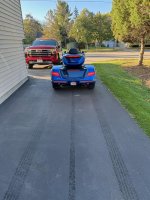Papa Zook
Staff member
- Admin
- #21
Yes you might save a little gas with the PSI at 50 because the tire contacting the surface will be less.
But the tires will not grip the road as well and would be subject to hydroplaning quicker because of the less contact with the road.
The centers will wear out first and can you imagine the destruction if the tire had a blowout with 50 psi in it.
From a safety stand point I don't think it's worth the little bit of gas saved.
JMHO
I'm in agreement with you Ted. I doubt there would be any appreciable difference in mpg and even if there was a slight gain, there are more downsides besides safety and extended tire life IMHO. I can tell you for sure the ride quality would be better at 24 or 25 psi than at 50 or 51 psi, especially for the passenger.
Anyone else who wants to join in the conversation and post up your Goldwing trike conversion chosen tire pressures, feel free to do so, as it's still a personal choice.







